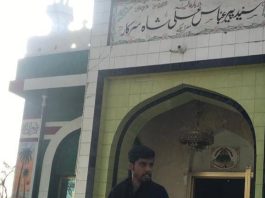
Karachi: Sindh, the first province to enact free and compulsory education in Pakistan, now lags far behind other regions of the country with more than half of the children of the province out of schools while the other half studying without buildings or teachers.
According to surveys conducted by Alif Ailaan, a campaign for education, out of the total 12 million children aged between 5 and 16 years in Sindh, more than half, nearly 6.1 million are out of school. On the other hand, for the children who are managing to go to schools, there are no adequate arrangements since 77% of the schools are in “unsatisfactory” condition, according to the Sindh Education Department.
The conditions of schools can be gauged from the fact that only one in every seven schools in Sindh has a boundary wall and almost half of them do not even have a toilet, states the data obtained from Alif Ailaan.
Two years ago, on March 06, 2013, the Sindh government enacted the Free and Compulsory Education Act under which every child between 5 and 16 years is entitled to be educated by the state. However, as demonstrated by the above-mentioned figures the province lags way behind in implementation of this landmark legislation.
Broken system
It would take at least 32,000 more classrooms in just Karachi to be able educate all the children in the district, said Shereen Narejo of the Sindh government’s Planning and Development Department while talking to News Lens Pakistan.
“In the case of the whole province, it would require millions of more classrooms to be able to educate the 6 million children who remain uneducated,” she added.
However, Narejo believes the problem is not just structural. The problems plaguing the education sector in Sindh have more to do with the gaps existing within the system. “Firstly, there aren’t enough middle and high schools in the province. Secondly, 82% of the children studying in grade 1 get dropped out of school by the time they reach grade 10 and more than 40% of them do so between grades 5 and 6.”
Moreover, as admitted by the Education Secretary in Sindh, Dr Fazlullah Pechuho, around 6,000 schools in the province were not functioning while nearly 40,000 “ghost” teachers did not show up to work.
Along with the dilapidated infrastructure, the key issue was persistent poor management of the education system, remarked eminent educationist Shahnaz Wazir Ali who is the President of a private university, Syed Zulfikar Ali Bhutto Institute of Science and Technology.
She believed that educational policies were flawed because they were made too far away from where they were supposed to be implemented.
“Those at the helm of affairs when making policies are not aware of the ground realities of their practical implications,” she said. “Keeping education planning centralized has led to its poor management. There was a need of better coordination and cooperation among departments and proper collection and analysis of dynamic data which is lacking greatly.”
For example, said Ms. Ali, for the past 30 years the Education Monitoring Information System had been providing static data to the government which required an interpretation of how it was affecting children’s enrollment and dropout rates in schools.
The “poor” planning being referred to by Ms. Ali is reflected in the budget allocation. According to the analysis of Institute of Social and Policy Sciences (I-SAPS), the provincial education budget does not address the real challenges. Ahmad Ali, the program leader for I-SAPS, said in the current fiscal year (2014-2015) the funds allocated for education (149.5 billion) witnessed an overall increase of 10 percent.
However, he said, 90% of the total increase was in the salary component while the development budget decreased by nearly 12%.
Political will
In his paper on Post-Devolution Status of Education in Sindh, the Director of Pakistan Study Centre at Karachi University, Prof. Dr. Jaffar Ahmad, attributed the bad management of education sector to the lack of political will.
In his paper, he argued that one of the reasons that provinces lacked the adequate capacity for educating children was because the provincial government fell short of the political will to do so.
According to Dr. Ahmad, for any legislation to be implemented in true letter and spirit, it had to be owned by the society and the government.
Education became a provincial subject in 2011 after the passage of 18th constitutional amendment in the parliament.
Ahmad said the people and the provincial governments both were not prepared to accept the changes brought by the law. This resulted in a lack of social ownership of the educational system, stemming from the lack of political will.
“It is the government’s responsibility to create enthusiasm among the people for reform and change. Our bureaucracy and government did not exhibit the sufficient enthusiasm in owning the responsibility of educating children in the province,” he further added.
Government’s response
On the one hand, the Education Minister Nisar Ahmed Khuhro admitted the failures of the education system, and on the other, he claimed that the government was doing what it could to rectify the problems.
He elaborated at length on the steps taken by the government under his leadership to be able to reopen closed schools and deal with the “ghost” teachers by banning postings and transfers.
He said the government had introduced a policy of confirming appointments on merit for “ghost” teachers by launching a test designed by the National Testing Service. He insisted that all the recruitment being done under his supervision was on merit.
To ensure the presence of teachers in schools, said Khuhro, he had banned transfers and postings except when teachers had to be transferred to a certain location to open up closed schools. He claimed that the number of closed schools had reduced by half, to nearly 3,000.
He said the provincial government had also introduced stipends, in addition to free books, for girl students to encourage them to continue attending school. He said 450,000 girls studying between grades 6 to 10 were receiving monthly stipends worth Rs3, 500 and Rs2, 500 in rural and urban areas, respectively.
He said 1,000 schools across the province with high enrollment had been earmarked for repair which would be performed with foreign funding.



